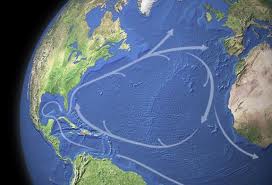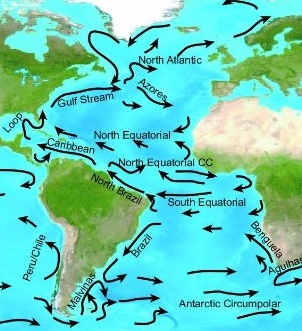European America or American Europe? Calculating the Probability of Pre-Columbian Contact December 9, 2012
Author: Beach Combing | in : Ancient, Medieval , trackbackThe idea of pre-Columbian contact between the Americas and Europe or even Africa has been one that has understandably excited a lot of attention. What are the possibilities that Europeans ended up in, say, Florida or that ‘Floridans’ made it to, say, Scandinavia in 1491? Well, in this post we are going to take the quite novel position of (i) ignoring the historical and archaeological evidence (such as it is) and (ii) concentrating on the wind and the waves. Why ignore the evidence (such as it is)? Quite simply because most of the evidence is suspicious or ambiguous or absent. And why concentrate on the winds and especially the waves? Because most speculations about contact between the spheres entirely fail to take this into account and it promises to give us a baseline.
Any theorising begins with the nature of the Atlantic itself. Let’s admit that save a couple of collapsing or arriving volcanic islands (Icelandwards) nothing much has changed in the ocean itself over the last four thousand years: we are certainly not going to tolerate (pace Plato) any missing continents around the Azores. The currents that today plague the Atlantic are, it is generally believed, the same ones that have turned around that ocean for the last four thousand years ago give or take a couple of degrees in latitude and temperature and give or take some pack ice. These currents are essentially the Gulf Stream and the North Equatorial. Together these form a clockwork rotating circle around the Atlantic going from the Canaries to the Caribbean and then from the Caribbean up the US coast before switching off towards Britain and Ireland and back down towards Africa.
These currents are crucial for understanding Atlantic travel and proved absolutely vital in the sixteenth century as European sailors began to use them. Essentially if you want to get to the Americas from Europe it makes sense to sail down towards Africa and then plunge out into the Atlantic letting the currents carry you westwards. Likewise if you want to travel from the Americas to Europe then it makes sense to head out in the great watery wildernesses somewhere between Florida and Labrador. If you take this advice your trip will be significantly easier as the current will push you in the desired direction. If you don’t you will be struggling against nature: that is no joke with oars and sails. Here is the reason that Columbus found it relatively easier to get to the New World but struggled, at first, to get back.
Before we even begin then there is a striking natural bias built into contact between the two hemispheres. It is far easier to get from America to Europe than from Europe to America. The only exception to this – though it was to become an important one! – would be any Europeans who managed to island hop around the top of the Atlantic: Iceland, Greenland, Labrador… There it was possible to step out of the major currents and to break down the long and dangerous journey into weeks rather than, say, a month or two months. There is a very slim chance that a Roman-era Greek text records an ancient case of northern island hopping.
We learn from Viking explorations in the northern Atlantic and down the coast of the Americas – did they perhaps get as far as Maine, they certainly got to what is today Canada? – that storms mattered. It was a storm that brought Gunnbjörn Ulfsson to Greenland: the first European (we know of) to have seen those lands. It was a storm that dragged Bjarni Herjólfsson from Iceland to America (when he had wanted to land in Greenland): again a first. Then there was comparable Irish kamikaze sailing… But how possible is it that say, a storm-tossed Irish sailor, a Gael, travelling from Dublin to Bristol could end up in, say, Haiti or likewise a Carib travelling from his home island to Florida could end up in Bristol?
Immediately, before considering the quality of vessels or seamanship, we have to recognise that the Carib had far better odds of arriving in Bristol (though God help him when he did) than our Gael had of arriving in Florida. If you put messages in the bottle in the water off Florida many will, in fact, arrive in Europe. If you put messages in the bottle off Galway they will, for the most part, end up on the coast of Europe or possibly Africa. As Merrien expressed it: getting from America to Britain takes fair winds, going the other way means ‘twice the distance, thrice the time and four times the sweat’. These are important words to remember.
How many days would our Carib and our Gael have to travel to get from one side of the Atlantic to the other. Let’s imagine abnormally ‘good’ winds blowing our Carib and our Gael towards their destination: the Carib first. A sloop named the Alice managed in the mid nineteenth century to get from North America to Britain in a mere twenty days. This though was highly unusual and in a boat that would not have been available to our Amerindian (his may or may not have had sails ). Let’s say that if a storm had blown him then in between twenty and forty days our Carib could have made it to Bristol: though it could equally have taken much longer. Our Gael would have needed, to use Merrien’s formula sixty to a hundred and twenty days and then only if the winds had continuously blown him against the currents, something that is almost unimaginable. (One medieval Irish source described a wind blowing westwards for a mere fifteen days: something that seems to have been exceptional). It has justly been said that it is almost impossible to imagine a European accidentally ending up in America, given the currents involved.
Let’s allow for miraculous conditions for the Gael though and accept merely exceptional ones for the Carib. Would either arrive alive at their destination? Well, neither the Carib nor the Gael were prepared for a long journey. They perhaps had food for a week in their boat: though they could have supplemented this with fish and rainwater on their travels. If the Carib had made a quick journey in, say, twenty to forty days then it is conceivable that he could have arrived alive though weak and cold in Europe. The Gael, on the other hand, would have been unlikely to survive because of the currents. But even if he somehow had then he would probably have died en route from lack of food and excess of exposure.
There are only two ways that Europeans were going to make it to the New World prior to Columbus. Either they were going to island hop over the top of the Atlantic as the Vikings and one fourteenth-century English sailor did. Or they were going to trail blaze for Columbus: namely, they would deduce that there was something out there and then deliberately set out into the waves with substantial supplies of food and even against the currents. (Any theorizing about this would depend on spherical earth theories.) The first happened, the second may have happened. What we need to remove from our historical imagination is the idea of Basque or Cornish fisherman, wandering into a storm and then waking up, after a few days banging up and down, in Virginia to be greeted as bearded gods by the locals.
Amerindian travellers on the other hands: be they Caribs or Inuits had far better chance of beating the Atlantic’s odds. Some will have been blown into the mid ocean and some may have arrived in Europe with breath still in their body: in the same way that American seeds and even American marine animals are occasionally blown across towards Ireland. And, of course, we have come across hints before in this blog that this is what happened from Roman times to Columbus’s times. One dogmatic thought though. If they were lucky enough to made it across, let’s not believe for a second that they had a chance of getting back to America, let alone their homes… drbeachcombing AT yahoo DOT com
Summed up America could only be discovered by Europeans deliberately going out to look for the Indies or by northern island hopping. Europe could be discovered by Amerindians accidentally or deliberately (directly or by island hopping): though if it had been discovered accidentally no news of that ‘discovery’ would ever have made its way back to the camp fires in Haiti or Newfoundland. Put in other terms if you come across references to Welsh Indians in Dakota, turn over and go back to sleep: unless you happen to think Madoc had got it all planned. If you come across references to Asiatic types in canoes in medieval Irish waters prick up your ears.
We don’t have enough evidence from pre-Columbian America to decide whether Amerindian culture could have deduced or would have risked a journey into the unknown in search of other lands. Beach would guess not: but perhaps he is the victim of centuries of Euro-centrism? We probably do have enough evidence from Europe, at least from Roman times onwards, to know whether Europeans were setting up deliberate attempts to find the New World: as we have fragmentary references to northern island hopping from the tenth century. The lack of references to deliberate searches prior to the fifteenth century is not decisive. But it is striking. Of course, we have assiduously avoided here the question of accidental or deliberate Nigerian visits to the New World… Now what a fun post that would be.




